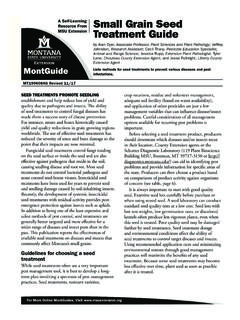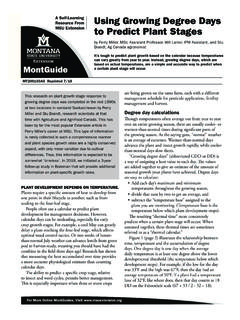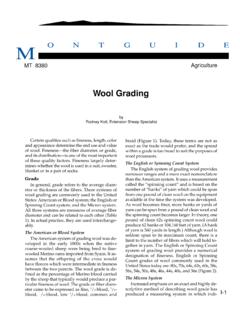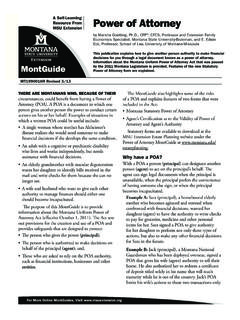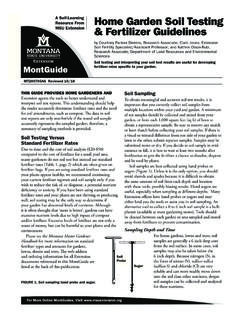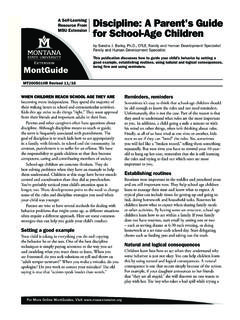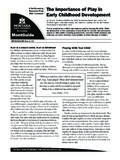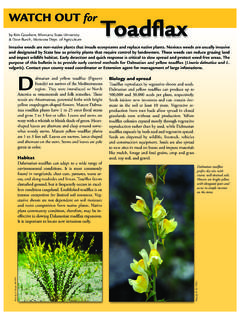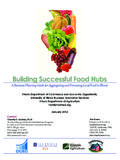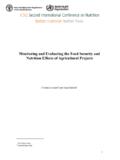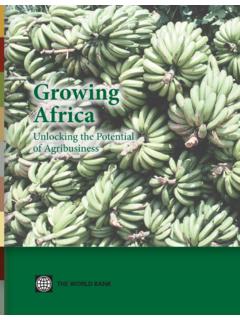Transcription of Growing Fruit Trees - MSU Extension
1 Growing Fruit Treesin MontanaEB02222 Hinsdale Fruit tree cultivar research site in Valley 2015 MSU ExtensionWe encourage the use of this document for nonprofit educational purposes. This document may be reprinted for nonprofit educational purposes if no en-dorsement of a commercial product, service or company is stated or implied, and if appropriate credit is given to the author and MSU Extension . To use these documents in electronic formats, permission must be sought from the Extension Communications Coordinator, 135 Culbertson Hall, Montana State University, Bozeman, MT 59717; e-mail: The Department of Agriculture (USDA), Montana State University and Montana State University Extension prohibit discrimination in all of their programs and activities on the basis of race, color, national origin, gender, religion, age, disability, political beliefs, sexual orientation, and marital and family status.
2 Issued in furtherance of cooperative Extension work in agriculture and home economics, acts of May 8 and June 30, 1914, in cooperation with the De-partment of Agriculture, Jeff Bader, Director of Extension , Montana State University, Bozeman, MT 59717 Growing Fruit Trees in Montana, EB0222 Toby Day, Montana State University Extension Horticulture SpecialistBrent Sarchet, Montana State University Extension Agent, Lewis & Clark County3 Introduction and BackgroundThe Bitterroot and Flathead Valley of Western Montana contain the majority of the Fruit production in Montana. While production in these areas does not compare to production in New York, Washington or Michigan, there are many commercial orchards; the number of orchards, however is extremely reduced from the boom era of the late 1800s and early 1900s when growers in these regions of Montana shipped Fruit all over the country.
3 Montana s Bitterroot Valley proved conducive to Growing apples by early settlers enticed westward by the Homestead Act of 1862. According to the Montana Historical Society, the first commercial apple orchard was planted in the Bitterroot Valley in 1870. The Flathead Lake sweet cherry industry was established in 1895 taking advantage of the lake effect, which helps prevent killing frost in winter. Sweet cherries and peaches still grow successfully in this the Homestead Act of 1862 was further expanded with the Homestead Act of 1909, settlers planted even more orchards. Many small orchards were planted near mining towns to supply Fruit to the miners. Fruit was a luxury at the time. Homesteaders planted small orchards, mostly apple, many of which survive today.
4 The pioneers were subsistence farmers, providing their own fruits, vegetables, grains, and as we look at Montana s local food systems, a common void is Fruit , both tree and small Fruit , with the exception of some regions of Western Montana. Thirty of Montana s 56 counties have areas considered food deserts, low income areas where at least 500 people and/or one-third of residents must travel more than 10 miles to the nearest supermarket (or one mile in urban areas). In Montana, nearly 72,000 individuals live in areas considered food deserts and have limited access to a grocery store or supermarket, making access to fresh, affordable food a daily challenge. (Montana Foodbank Network, 2015).Montana State University (MSU) Extension looked to encourage more residents to plant orchards by conducting research and developing appropriate resources.
5 Fruit tree research had not been conducted in the state since the late 1970s, and that research was limited to the western region of the state. In fall of 2012, MSU Extension was awarded a Specialty Crop Block Grant through the Montana Department of Agriculture to establish Fruit tree cultivar research sites across the state. By the spring of 2014, eight replicated sites had been established. This project received a Montana Department of Agriculture Growth Through Agriculture Grant in the spring of 2015 to establish two additional sites. Current research sites include: Helena, Winston, Whitehall, Columbia Falls, Power, Bozeman, Hinsdale, Colstrip, Shelby and Lodge Pole. At each site, apple, pear, plum and sour cherry cultivars are being evaluated.
6 A Specialty Crop Block Grant from the Montana Department of Agriculture in 2014 was awarded to conduct research on heritage orchards across the Montana Heritage Orchard Program currently has 34 sites across the state. There are 100-plus-year-old orchards located in all parts of Montana. For more information on the program visit the web site, This Fruit tree production guide is developed through research conducted in the programs mentioned. As data is compiled, this publication will be updated and expanded. The purpose of this guide is to provide a future orchardist with enough information to begin an orchard. Additional questions can be addressed to local Extension agents and/or Horticulture Specialists.
7 For information on apple diseases, please refer to the MSU Extension MontGuide (MT200812AG) Important Apple Diseases in Montana and Recommended Varieties for Resistance. It is online at Redman orchard and Fruit tree research site in Whitehall. 4 Stake or flag site ahead of planting to ensure row widths accomodate equipment and watering, and to monitor natural drainage SelectionSite selection is the most important component of a successful orchard. Site selection is often overlooked by novice and experienced growers alike. Trying to correct problems on a poor site can result in high material and labor costs. The right combination of micro climate and soil type can be critical for future orchard of a good site include: well-drained deep soil, good southern exposure, an uphill 4-8 percent slope where cold air will not settle, and available dependable water often through irrigation.
8 Many heritage orchard sites are on southern and/or eastern hill slopes. Southern exposure is preferred, but eastern exposure can help combat the coldest part of the day, often just before sunrise. Getting early morning sunlight into an orchard can be beneficial for withstanding cold temperature extremes. The site also needs to be fenceable to keep deer, elk, and other browsing animals out of the orchard. The cost of fencing an orchard is significant, and often overlooked. Few sites in Montana will escape the threat of wildlife damage, so plan accordingly. Can a marginal site be improved? Little can be done to the soil of an entire site without great expense or several years of soil building prior to planting.
9 One of the biggest environmental factors that could eliminate potential orchard sites in Montana is wind. Orchards in the prairie provinces of Canada with windbreaks provide examples of wind and micro climate management for Growing tree Fruit . Windbreaks can be established many years prior to orchard establishment to reduce wind effects. Early planning is critical if a windbreak is necessary. A windbreak needs to be at least the height of the Fruit Trees to successfully affect the a Production System There are many different orchard production systems, and few have been implemented or trialed in Montana. A system is a combination of planting, spacing, trellising and pruning techniques. The most common apple production systems include: Slender Pyramid, Vertical Axis, Slender Axis, Tall Spindle, Super Spindle, and the traditional system of low plant densities (100 200 Trees /acre).
10 The production systems densities vary from 340 to 2,200 Trees per acre (Robinson, et al.). Work done by Robinson, et al. at Cornell University has found that optimum planting densities are close to 1,000 Trees /acre. This was determined from estimating the net present value for each system over 20 years. However, this does not mean that traditional planting systems cannot be profitable; much depends on individual markets and operation costs. Choosing which production system is best is contingent upon many factors including: location, amount of available land for the orchard, available labor (including skilled labor versus unskilled labor), and available Preparation Proper site preparation cannot be overlooked.
